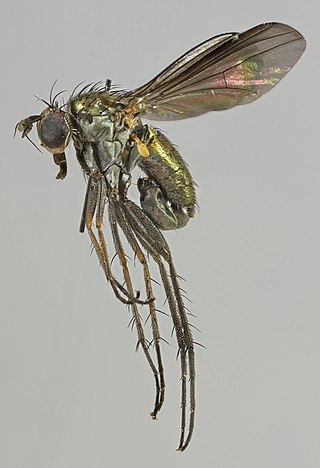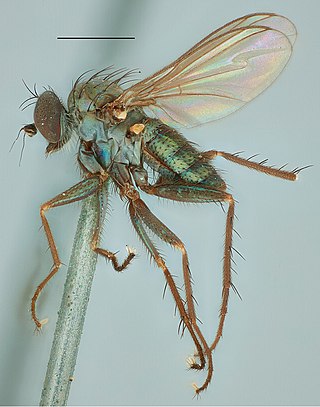
Hercostomus is a genus of flies in the family Dolichopodidae. It is a large genus, containing more than 483 species worldwide. Multiple studies have shown that Hercostomus is a polyphyletic assemblage of species.
Acropsilus is a genus of flies in the family Dolichopodidae. It is unplaced in the family, having been placed variously in subfamilies such as Sympycninae or Peloropeodinae. It is superficially similar to the Medeterinae.
Anasyntormon is a genus of flies in the family Dolichopodidae. It was originally placed in the subfamily Rhaphiinae near Syntormon. It was transferred to Dolichopodinae by Hans Ulrich (1980), who found it to be congeneric or closely related to Hercostomus.

Asyndetus is a genus of flies in the family Dolichopodidae. There are more than 100 species described for the genus, distributed worldwide.
Katangaia is an African genus of flies in the family Dolichopodidae. It was originally placed in the subfamily Rhaphiinae, though it was later transferred to Dolichopodinae. In 2005, based on a cladistic analysis of the subfamily, Scott E. Brooks excluded Katangaia from the Dolichopodinae. However, later authors have retained the genus in this subfamily.

Lichtwardtia is a genus of flies in the family Dolichopodidae. In a phylogenetic analysis of the subfamily Dolichopodinae by Scott E. Brooks in 2005, Lichtwardtia is considered to be a synonym of Dolichopus, but other authors retain it as a valid genus. Before this, it was considered a possible subgenus of Pterostylus by Oleg Negrobov (1979).
Micromorphus is a genus of flies in the family Dolichopodidae.
Nurteria is a genus of flies in the family Dolichopodidae, found in the Afrotropical realm. Three species are currently known in the genus, but there are also numerous undescribed species of the genus from southern Africa. It was originally described in the subfamily Diaphorinae, though it possesses some features of the Sympycninae.

Sybistroma is a genus of flies in the family Dolichopodidae. It includes over 50 species, described mainly from the Palaearctic and Oriental realms. A single species is known from the Afrotropical realm. Until 2005, the genus was thought to be restricted to the Mediterranean in distribution, with five known species. It was recently expanded to include the former genera Hypophyllus, Ludovicius and Nordicornis, as well as some species of Hercostomus.

Tachytrechus is a genus of long-legged flies in the family Dolichopodidae.

Hydrophorinae is a subfamily of flies in the family Dolichopodidae. Several studies have found evidence that the subfamily in its current sense is polyphyletic.

Dolichopodinae is a subfamily of flies in the family Dolichopodidae.
Afropelastoneurus is a genus of flies in the family Dolichopodidae. It includes five species from Africa formerly placed in Paracleius or Pelastoneurus.
Apelastoneurus is a genus of flies in the family Dolichopodidae. It includes 47 species from Africa formerly placed in Paracleius or Pelastoneurus.
Pseudargyrochlamys is a genus of flies in the family Dolichopodidae. It was first established by Igor Grichanov in 2006 for four species of Paracleius from eastern South Africa. A fifth species from South Africa was described in 2020. Members of the genus are restricted to the coast of southern Africa between East London in South Africa and Maputo in Mozambique. The genus is closely related to Argyrochlamys and Phoomyia, which are also found in coastal habitats.
Pseudoparaclius is a genus of flies in the family Dolichopodidae. It was established by Igor Grichanov in 2006, for 14 species from Africa that were originally placed in Paracleius. Two additional species were described in 2015 and 2020.
Pseudopelastoneurus is a genus of flies in the family Dolichopodidae. It includes two African species that were formerly classified in the genus Pelastoneurus.
Neohercostomus is a genus of flies in the family Dolichopodidae. Many of the species were formerly from "Hercostomus Group III", one of three groups of Afrotropical Hercostomus species created by Igor Grichanov in 1999.
Phoomyia is a genus of flies in the family Dolichopodidae. The genus is known from the coasts of Sri Lanka, Thailand and East India, and is closely related to Argyrochlamys and Pseudargyrochlamys. Species of Phoomyia appear to be restricted to sandy ocean beaches, where they are often found near the burrows of ghost crabs.






